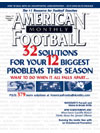AMERICAN FOOTBALL MONTHLY THE #1 RESOURCE FOR FOOTBALL COACHES
Article CategoriesAFM Magazine
|
The Strength Report: Core Trainingby: Ron McKeeferyAsst. Athletic Director, Strength & Conditioning, University of South Florida © More from this issue If I told you I could guarantee that you would improve your strength, power, and speed would you do what I asked? When athletes are unable to perform football skills, one of the most common breakdowns is posture. Posture is primarily controlled by your core. It doesn’t take long walking onto a practice field to hear a position coach barking posture coaching cues. Everything from the stance to the transfer of power for a kicker is controlled by the core. A strong core is essential for optimal performance enhancement. Injury prevention is the other reason to train the core. The human body gets put into several awkward positions when it is tackled in a pile. By conditioning the athlete with exercises training the entire core musculature you help to prevent injuries that may occur. The core is made up of the Rectus Abdominals, Transverse Abdominals, Internal/External Obliques and Erector Spinae. The movements of the core are required synergistically to play the game of football. Every play involves trunk flexion, stabilization, rotation, and extension. The Rectus Abdominals are responsible for trunk flexion and are what is trained most commonly when training the abdominals. Exercise such as sit-ups, crunches and toe touches all train the Rectus Abdominals. The Transverse Abdominals are responsible for trunk stabilization. This muscle lies beneath the Rectus Abdominals and maintains posture. Exercises such as leg lifts, leg lift holds and pillars train the Transverse Abdominals. The Internal/External Obliques are responsible for trunk rotation. Exercises such as side crunches, med ball rotational throws and side pillars train the Internal/External Obliques. The Erector Spinae is responsible for trunk extension. It is located on the lower back and is trained with exercises such as: hyperextensions, reverse hyperextensions and superman exercises. We train the core in all four planes every workout. Our core training program is performed after the warm-up as a team. We find that performing it at that time is best for us logistically. Don’t get caught up too much in when it is performed, but rather that it is executed and performed correctly. I would caution that if you are going to conduct an extremely intense core workout followed by highly technical lifts, you should wait until the end of the workout to conduct your core training. We conduct the core training as a team to incorporate some team building concepts. We focus on accountability; every rep must be performed correctly and done in unison with the team. If someone is lagging behind or is too fast we start over. Leadership is developed when we allow the team leaders to choose the exercises and then lead the team through them. Camaraderie is fostered by changing the execution. Instead of counting we may call out ‘beat’ and the team executes the exercise and responds ‘our opponent.’ It creates a sense of pride in what we are doing rather than just performing abdominal exercises. We will perform 200 reps. If the exercise is very difficult we will assign a rep value to it. For timed exercises we count one second as a rep. For example, if we are doing 60 second pillars, that counts as 60 reps. Training the core increases athletic performance and reduces the risk of injuries. It must be included into your program design. Here are ten core workouts you can incorporate into your workouts: CORE ROUTINE 1 Bicycles x1 min Jackknifes/pikes (2 second hold) x15 Side pillar x45 second Jackknifes/pikes (2 sec hold) x15 Side pillar x45 second Jackknifes/pikes (2 sec hold) x15 Front pillar x1 min Routine 2 - (MedBall solo workout) Reach ups x30 Side touches x60 Sit-ups x30 Alternating sit-ups x30e Routine 3 Flutter kicks x80 Rollups x20 Supermans x20 Crunches w/1 leg in/1 leg out x25 each way Supermans x20 Rollups x20 Supermans x20 Routine 4 Alternating jackknifes/pikes x20e Reach ups x50 Bicycles x40 Crunch holds (5 sec each rep) 3x15 Alternating supermans 3x15e Routine 5 (MedBall Partner Workout) x2 Seated side throws x30e Overhead sit-up throw x30 Back extensions - hold light MB overhead x15 Routine 6 Crunches x25 Bicycles x50 Oblique crunches x25e 10 sec negative crunches x15 10 sec negative oblique crunches x15e Reverse hypers 2x25 Routine 7 (Theraball Workout) Sit ups 2x50 Side sit ups 2x25e Reverse crunches x20 Routine 8 (Theraball Workout) x2 Crunches x30 Diagonal Chops x15e Reverse Hypers x15 Reach Ups x30 Reverse Hypers x15 Routine 9 Partner MB Side Throws x20e Theraball MB Throws (one arm catches) x30 each Super Slow Crunches x10 (30 sec each) Routine 10 (Lower Abs) x3 Hanging Knee Ups x30 Quadrapeds x15e Hanging Twist Knee Ups x15e |
|
| HOME |
MAGAZINE |
SUBSCRIBE | ONLINE COLUMNISTS | COACHING VIDEOS |
Copyright 2024, AmericanFootballMonthly.com
All Rights Reserved




